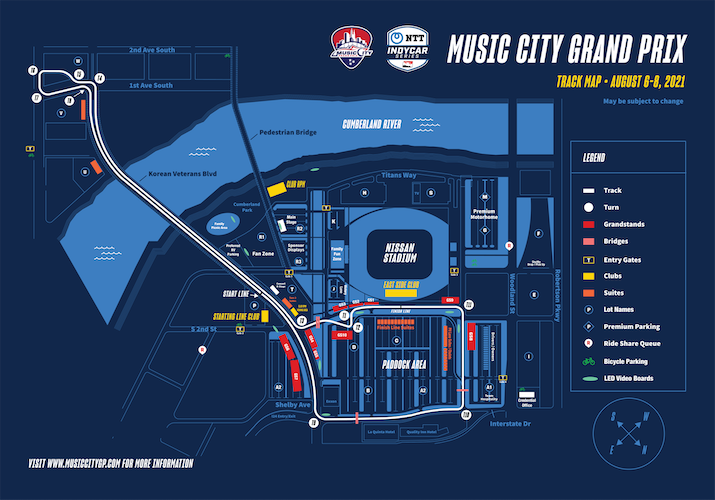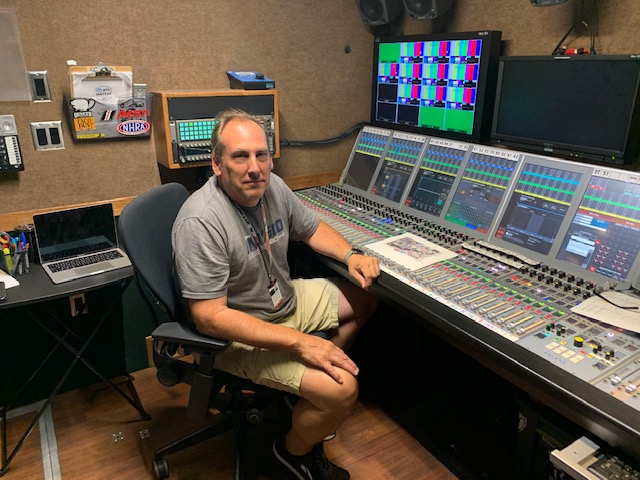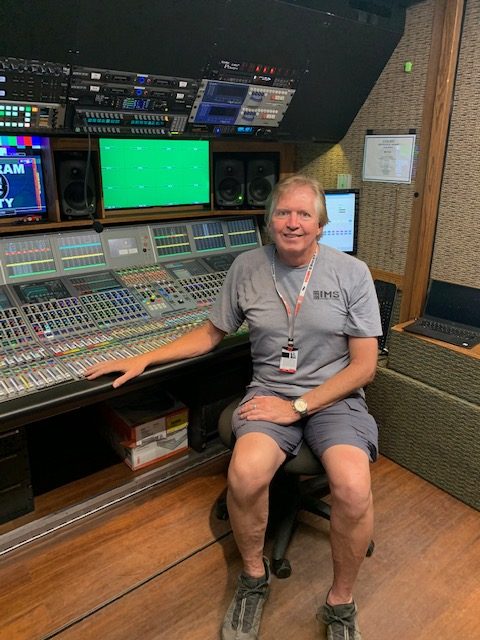Nashville Grand Prix Arrives in Music City With a Sound All Its Own
The NTT IndyCar Series race poses singular challenges for the audio folks
Story Highlights
Nashville is the site this weekend of the Big Machine Music City Grand Prix, the season’s second-largest NTT IndyCar Series race, with 28 cars competing on a 2.17-mile track layout in the city’s downtown area. Produced by IMS Productions, the broadcast on Sunday (5:30 p.m. ET, NBCSN) will deploy a small army working from three IMS mobile units with plenty of audio firepower to capture that IndyCar roar.
With 2,000 barriers and fence panels in 12-ft. sections, the course traverses the Korean War Veterans Memorial Bridge over the Cumberland River and circumnavigates Nissan Stadium, where 1,200 linear ft. of 18-ft.-wide concrete pit boxes have been built and a pit lane repaved in the parking lot. The race is scheduled for 80 laps, during which competitors will cover 173.6 miles on a temporary street circuit with 11 turns.

The Music City Grand Prix covers 173.6 miles in 80 laps on a street circuit — and the Korean War Veterans Memorial Bridge.
The event is bookended by concerts on Friday and Saturday — featuring Jamey Johnson, Vince Neil, Tyler Farr, and other artists — and a post-race “Grand Ole Prix” show on Sunday with Alan Jackson, Justin Moore, Riley Green, Danielle Bradbery, and Callista Clark. It’s expected to be the largest sports event to take place in the city outside of a conventional sports venue since the 2019 NFL Draft took place there. That three-day event brought in 600,000 people.
For the Music City Grand Prix, IMS Productions, which also produces the Indianapolis 500 race, has rolled in IMS HD-5 mobile units. To capture that familiar sound, an estimated 60 microphones are being deployed, including 15 Audio-Technica AT-4027 stereo shotguns mounted on cameras, two Sennheiser 416 short shotguns on each of eight robo/POV cams, three ShureVP88s stereo condenser microphones (for the “roar” effect), four A-T AT-4029 stereo shotguns for crowd mix, and three or four daisy-chained Sennheiser MEG 66 supercardioid shotguns on seven of the 11 turns to capture the approaching downshift sound. In addition, 11 of the 28 cars in the race will be fitted with cameras and microphones, remotely controlled by BSI, which is onsite providing the wireless infrastructure for the race.
The Bridge Over the River Cumberland
It will be a unique race, but, if you ask everyone what’s most singular about it, you tend to get a very consistent answer.
“The bridge,” says A1 Mike Pope, who has mixed numerous Indy 500, NASCAR, and IMSA races over the past 30 years, going back to the old Saturday Night Thunder races on ESPN.
“That bridge,” says Rob Sweeney, the race’s audio submixer, who plots microphone placements around the course with a staff of sharp-eared A2s.
“The bridge,” says IMS Director, Operations, Ken Ferguson.
“The bridge,” adds BSI RF EIC Miles Denton.

Submixer Rob Sweeney sums up the challenge of the bridge: “It’s the fastest part of the track, and it’s where the cars are going in both directions, plus it’s real compact.”
“That bridge” is the 1,660-ft.-long, 102-ft.-wide clear-span Korean War Veterans Memorial Bridge, which normally accommodates an estimated 17,000 cars a day but, on Sunday, will have 28 cars hitting close to 200 mph. In both directions. Simultaneously. Capturing that sound will be pulling a very loud rabbit out of a very slender hat.
“I’ve never done IndyCar over a bridge like this on a modern circuit,” says Ferguson. “It’s hard to get a camera on there, so we’re using robotic cameras on it. The fence builder for the race worked with us, making custom cuts in the fence panels for the cameras.”
Seven Sony P1 robo cams using Talon robotic systems are being deployed, along with four Sony HDC-4300 super-slo-mo cameras, a P-4300 robotic with super-slo-mo capability, and seven Panasonic HC-X1500 POV cameras — all of which are available for both broadcast and live-event use. In addition, 12 Sony 2500 manned cameras and four handheld cameras (including one jib-mounted) are dedicated to the NBC Sports production. And there’s a helicopter-mounted camera.
Denton describes the bridge as “unique” in Grand Prix courses. His crew had to lay fiber along the length of the span for the RF in-car transmission infrastructure while the bridge was still in use by daily commuters. It was closed off on Thursday to prepare for practice runs.
Pope also marvels at the bridge but acknowledges that, in some ways, the race could be just another auto race once it comes up on his 144-input Calrec Apollo console aboard the HD-5 A unit. The faders of wireless radio channels from 11 racers are arrayed on one central section of the board, with other sources around them: announce-booth talent, RF talent packs, graphics sound effects, crowd mics, EVS playbacks. And, of course, the sound-effects channels from submixer Sweeney’s Calrec Artemis desk on a 5.1 fader are close at hand. Pope’s particular challenges, though, include learning the distinct acoustical signatures of this racecourse, which weaves among the glass-and-stone high-rise offices and hotels that have overtaken much of this part of Nashville’s downtown in recent years.

A1 Mike Pope’s particular challenge in mixing the Big Machine Music City Grand Prix has been the distinct acoustical signatures of a course among glass-and-stone high-rises.
“We have some of the same sort of [acoustical considerations] with the Pagoda at Indy,” he notes, referring to the Indianapolis Motor Speedway’s architectural icon. “Especially last year, with no one in the stands.”
Also, Pope says, the engine sounds are much higher-pitched than at Indianapolis or NASCAR tracks. They’re closer to where the human voice is, around 1K, making it harder to capture in some circumstances. “It’s very different from NASCAR, where the [dominant] frequencies are much lower and more omni.”
The audio comes into the production compound over a network of eight Calrec Hydra boxes and CCU inputs plus Dante for additional mics like downshifts and are shared between the mix and submix.
In addition, there is a radio-mix console, a Calrec Brio manned by mixer Pat Sellers, who Pope says will have all of 1.5 seconds to decide if a particular snippet of driver dialog might warrant inclusion in the broadcast. HD5 EIC Steve Dixon notes the large Evertz system beneath the truck, where the main EQX video router interfaces with an EMX audio router, which is capable of processing MADI, analog, and AES audio.
Submixer Sweeney has a lot of ground to cover and would spend most of the prerace runs looking for the sweet spots for effect capture. The turns are of particular importance because of the vast contrasts in timbre and SPL as cars downshift on the approach and upshift as they accelerate out of the turn.
“We start by looking at a map of the course, then assigning mics based on that,” he explains. “For instance, Turn 1 will likely have a big downshift, so we’ll start with three or four microphones on that, daisy-chaining ME66s 100, 200, and 300 ft. out ahead of it. But, as the drivers get more used to the course and the turns during practice runs, they’ll downshift later and later, so we’ll adjust the mic positioning accordingly. The A2s will be out there listening to it. Their ears are the best way to determine where the mics go.”
Then there’s that bridge.
“It’s the fastest part of the track, and it’s where the cars are going in both directions, plus it’s real compact.” Sweeney concisely lays out the main challenges. ”We’ve never had that before. This is going to be interesting.”
This is the first Grand Prix in Music City, but it apparently won’t be the last. The event’s ownership group has signed a three-year agreement that guarantees options for two more years and the potential for additional opportunities after that.
“Our goal is to have this become part of the Music City, the Nashville calendar for years to come, just like they’ve done in Long Beach [CA] and St. Petersburg [FL],” Big Machine Music City Grand Prix President Chris Parker told NBC affiliate WSMV Nashville, citing a projected annual economic impact between $23 million and $35 million. “We’re here for three years initially. We expect to be here for 15, 20, 30 years or more.”
